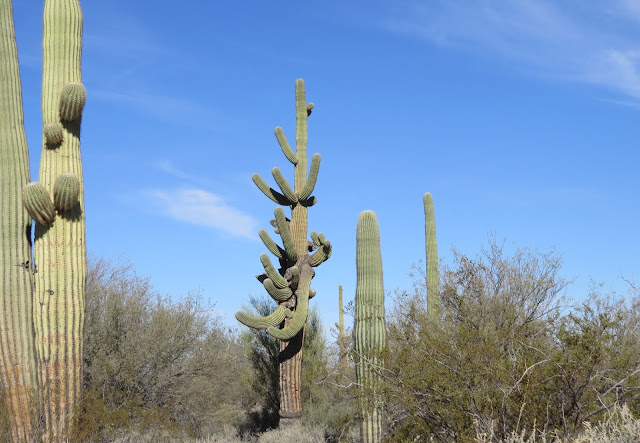We drove out North Puerto Blanco Drive to the trailhead. Those are the Puerto Blanco Mountains in the distance.
Pinkley Peak is the highest mountain in the range.
Pinkley PK, 3,145 ft
We will walk as far as Baker Mine and back. Bring plenty of water, and don't forget your snacks like I did. I left them in the car, and Anita had to share hers.
Looking back at the car at the trailhead. We did stop at the Visitors Center to make sure it was safe to hike in this area today. They assured us it would be. We were not near the border.
This trail follows historic mining roads that connected a series of mines in these mountains.
In fact, Anita spotted an old mine entrance right away. I had to crop out most of the picture to avoid a butt shot, lol.
This trough was beside the mine opening, and no doubt was used in the mining process somehow.
We passed a Cactus Wren nest in a Cholla. No one was home.
This part of the trail was easy, and it was still cool outside.
The trail splits after about a mile. To the right the trail leads to Baker Mine and Milton Mine farther on. To the left leads to other trails.
Straight ahead is Red Tanks Tinaja, small natural basins in a red sandstone wash.
I learned a new word for me. "Tinaja is a term originating in the American Southwest for surface pockets (depressions) formed in bedrock that occur below waterfalls, are carved out by spring flow or seepage, or are caused by sand and gravel scouring in intermittent streams (arroyos). Tinajas are an important source of surface water storage in arid environments. These relatively rare landforms are important ecologically because they support unique plant communities and provide important services to terrestrial wildlife."
Animals come here to drink. Do you see the Gila Woodpecker?
Red Tanks Tinaja
Behind me is the trail to Baker Mine.
The old road gets rocky.
And starts uphill.
We pass a lot of Organ Pipe Cacti and some Saguaro.
Looking back.
A lot of different kinds of cacti in this picture. How many can you name?
Another Gila Woodpecker.
We passed several Packrat nests. In the campground, many campers leave their engine hoods up to discourage packrats from building a nest in them. I took my chances and left mine down.
More trail views...
I think this type of Organ Pipe cactus is referred to as Totem Pole.
There were a few Agave, or Century Plant.
By now it is getting pretty hot out there.
Surely we are almost there.
Anita, who has more experience finding desert mines, spotted some mine tailings on that mountain over there.
Mine tailings.
We made it to Baker Mine, and we had already decided it was too hot to go on any farther.
Baker Mine has two entrances. One below, shown here:
And another up there, covered with an iron grate.
I could walk up to the lower entrance and peek inside.
The mine tunnel. Notice the Packrat nest in the lower left just inside the entrance.
We sat down on some rocks to eat (Anita's) snacks, and noticed some rusty iron and tin cans laying around.
Perhaps the mine workers sat here to eat too.
And then we hiked back.
Past the Organ Pipe Cacti,
Past the Giant Saguaro,
Looking toward the Ajo Mountains.
Past Red Tanks Tinaja to the parking lot.
This was Hike #5 of the 52-hike challenge for me.
























































































